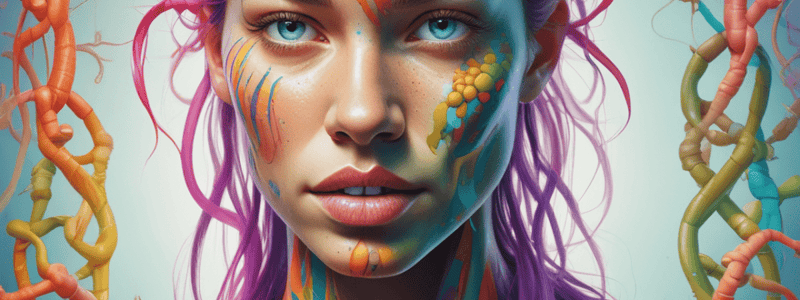Podcast
Questions and Answers
What are the components of genetics discussed in the slides?
What are the components of genetics discussed in the slides?
DNA, genes, chromosomes
How is genetic information stored in humans?
How is genetic information stored in humans?
In DNA
How many pairs of chromosomes are found in a typical normal human cell?
How many pairs of chromosomes are found in a typical normal human cell?
23 pairs
Where do individuals inherit one member of each pair of chromosomes from?
Where do individuals inherit one member of each pair of chromosomes from?
What are homologous chromosomes?
What are homologous chromosomes?
What is the structure of DNA that contains genetic instructions for living organisms?
What is the structure of DNA that contains genetic instructions for living organisms?
Explain the inheritance pattern of X-linked disorders when a heterozygous carrier female parent mates with a normal male parent.
Explain the inheritance pattern of X-linked disorders when a heterozygous carrier female parent mates with a normal male parent.
Describe the impact of point mutations in genetic disorders.
Describe the impact of point mutations in genetic disorders.
What is the pathogenesis of autosomal recessive disorders caused by loss of function mutations?
What is the pathogenesis of autosomal recessive disorders caused by loss of function mutations?
Explain the genetic implication of Y-linked inheritance.
Explain the genetic implication of Y-linked inheritance.
How do rare traits in a population affect the probability of parental consanguinity?
How do rare traits in a population affect the probability of parental consanguinity?
What are the medical implications of genetic disorders?
What are the medical implications of genetic disorders?
What type of genetic disorders are caused by the combined actions of environmental factors and two or more mutant genes?
What type of genetic disorders are caused by the combined actions of environmental factors and two or more mutant genes?
In which type of genetic disorders do most individuals who inherit the anomaly show phenotypic effects?
In which type of genetic disorders do most individuals who inherit the anomaly show phenotypic effects?
What is the classification of genetic disorders caused by a single mutant gene that affects transcription, mRNA processing, or translation?
What is the classification of genetic disorders caused by a single mutant gene that affects transcription, mRNA processing, or translation?
What is the inheritance pattern in autosomal dominant disorders?
What is the inheritance pattern in autosomal dominant disorders?
Which genetic disorders are caused by loss of function mutations resulting in inactive or decreased regulatory proteins?
Which genetic disorders are caused by loss of function mutations resulting in inactive or decreased regulatory proteins?
Give an example of an autosomal dominant disorder caused by gain of function mutations.
Give an example of an autosomal dominant disorder caused by gain of function mutations.
What type of inheritance is suspected in a pedigree showing affected siblings with normal parents?
What type of inheritance is suspected in a pedigree showing affected siblings with normal parents?
In the mating of two phenotypically normal heterozygotes, what is the segregation frequency with each pregnancy?
In the mating of two phenotypically normal heterozygotes, what is the segregation frequency with each pregnancy?
What type of genetic disorders show additive effects with the number of inherited mutant genes?
What type of genetic disorders show additive effects with the number of inherited mutant genes?
Which category of genetic disorders includes conditions like storage diseases and inborn errors of metabolism?
Which category of genetic disorders includes conditions like storage diseases and inborn errors of metabolism?
What are the two basic functions of DNA?
What are the two basic functions of DNA?
Define genes and chromosomes.
Define genes and chromosomes.
Explain how genetic information is translated into proteins.
Explain how genetic information is translated into proteins.
What are mutations?
What are mutations?
What are the two types of mutations based on the cells they occur in?
What are the two types of mutations based on the cells they occur in?
What are Mendelian disorders?
What are Mendelian disorders?
Explain chromosomal disorders.
Explain chromosomal disorders.
What are numerical anomalies in chromosomes?
What are numerical anomalies in chromosomes?
Describe Down syndrome.
Describe Down syndrome.
What are multifactorial disorders?
What are multifactorial disorders?
Flashcards are hidden until you start studying




